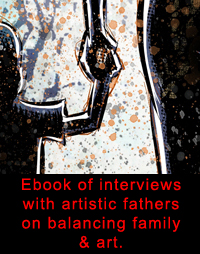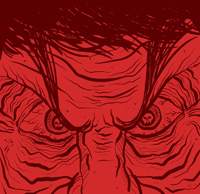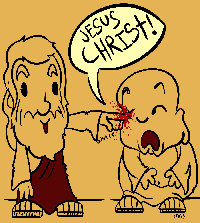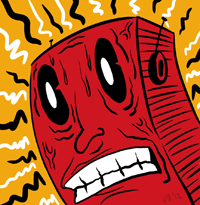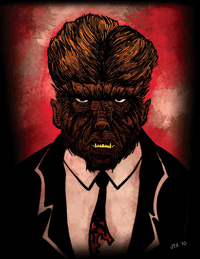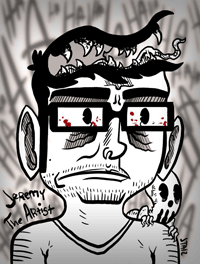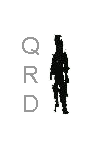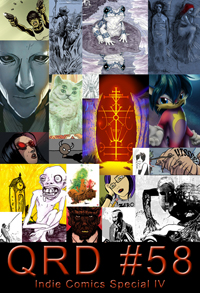
February 2013
City: Austin, TX
Comics: My Talking Head, Mortem Apocalypsi, The Axeman
Websites: (webcomic site) www.mytalkinghead.com, (to buy comics) www.etsy.com/shop/jeremytheartist, (portfolio site) www.jeremytheartist.com
QRD – How old were you when you first got into comics & did you always stick with them or did you come back to them?
Jeremy – My dad had these red plastic crates, 2-3 of them, of old Marvel comics - they were even indexed, categorized by which superhero title they were. The pages were transitioning yellow; those comics had that nice “old book smell”. Those crates were my very first exposure to comics… & that was probably around 6 or 7 years old. Granted, I didn’t always read them & just looked at the pictures… but I fell in love with the art & the panels… from there, my love only grew. I’d buy my own comics starting 5-6 years later… particularly Spawn & Spider Man. Around the age of 14 I fell out of the world of comics & came back to it when I became employed with my first job around 17 - parents weren’t giving me an allowance anymore so I needed my own bread, ha-ha.
QRD – What was the first comic book you ever bought?
Jeremy – First comic I ever bought, I’m not quite sure I can confidently say what it was… I was a hardcore Spawn fan & a devout Image fan when I was “really” into comics that first go around.
QRD – How old were you when you put out your first comic?
Jeremy – I put out my very first comic when I was 25 (last year, ha-ha), called “My Talking Head, issue #1”- which is a collection of some of my favorite web comics from the site of the same name. Since that time, I’ve produced two additional comics, which are completely different entities & I am currently working on an art book & another comic title.
QRD – What decade do you think produced the best comics?
Jeremy – The 90s, I say - Marvel was doing neat things & still in my opinion seemed somewhat sane - Image, Top Cow, & all those Image guys’ comic companies were producing some awesome stuff that I loved at the time.
QRD – Why comics instead of just writing or drawing?
Jeremy – So I actually write amateur poetry & I freelance illustration work; also moonlighting as a caricaturist... but writing & drawing separately, I find, does not give me the same satisfaction as writing & drawing a comic. Comics to me are like a print version of a film. Films use storyboards to illustrate their shots & how certain actions will be carried across. Comics ARE story boards, to some extent, so in a way you’re creating your own movie right at the moment you put the pencil to paper. Being able to tell my stories & share them with others in a visually aesthetic manner is one of the greater joys in my life & something I hope to only get better at.
QRD – Do you see mini-comics & indie comics as paths to mainstream comics or as their own unique media?
Jeremy – Own unique media. Being that I’m fairly new to the indie/underground comic world, I was always swimming around in the mainstream pool... which is always a crowded, really small area to swim… & then someone poops in the pool & everyone has to suffer. Indie comics is like a hidden beach… not everyone knows about it, but beautiful water & plenty of room to play around. I can see myself producing indie comics for the rest of my life - granted, I will try to make them as well known as possible, ha-ha.
QRD – How many copies of your comic do you print in your first run?
Jeremy – I’m still in the “struggling artist” phase & a small time print guy - most I’ll do is a 100.
QRD – How much do you think comics should cost?
Jeremy – $2. Graphic novels should run $15, all of them…I used to find both comics & graphic novels at these given prices & now they’re more expensive.
QRD – How many books do you produce a year & how many would you like to?
Jeremy – I produce 100. I’d like to produce 5,000. Currently working on achieving this.
QRD – Do you think stories should be serialized or delivered as complete works?
Jeremy – As I’ve gotten older, I started collecting graphic novels of complete works versus the individual issues. I think what attributes to this is my age/current free time. I’m always working on something(s), so when I give myself a break to read/watch TV/what have you, I want to be completely relaxed & have everything I need in front of me. That being said, I’m really into watching entire TV series that are available for web streaming via Netflix. I can say the same thing for my comics… especially if I’m really into it, I hate having to wait around for the next issue… because with my schedule I may just miss that particular issue & there’s just more effort put into finding the comic than reading the comic for me. At least at this point in time.
QRD – How are comic strips different than comic books & which medium do you prefer?
Jeremy – I’ve done both strips & comics now, so I can more so see the difference. Let’s say there’s this guy who goes jogging every day. Really good jogger, 6 miles every day in good time - keeps healthy. Now, there’s another guy who keeps healthy… not only does he jog, but he sprints… & not only does he sprint, he lifts weights. Both are in good shape… but one does more extensive workouts. Comic books are the more extensive work out, I’d say - more involved, more panels to work on, more art to create. Strips also usually don’t have to worry about panel space/layout design as much as comics, which is probably something I’d highlight in this particular answer. I do, however, thoroughly enjoy creating both strips & books.
QRD – How long is it from when you start a comic until it’s printed?
Jeremy – Depends on what I have going on at the moment - my life at this juncture is completely insane with the workload I carry from the two jobs I work while making comics. With comics, I usually outline the story & write out some main ideas, create some thumbnails & then just dive in.
Mortem Apocalypsi, my zombie armageddon comic, I started scripting in May 2012, drawing in June - but then got so busy with commission work & what not that I couldn’t get back to it until late September… it was at this time that me & another comic artist were preparing for Wizard World Austin Comic Con, which was at the end of October - & my friend wanted me to create a separate title under him within this month’s time, if possible. I then tasked myself with this project, immediately dove headfirst into my 3rd comic, The Axeman, & drew that simultaneously while finishing up Mortem Apocalypsi.
Mortem, 24 pages, time to finish: about 3.5- 4 months.
Axeman, 12 pages, time to finish: one month.
QRD – What do you do better with your comics now than when you first started?
Jeremy – As I do more & more comics (web comics included), my sense of space, composition & panel layout, at least in my personal opinion, is growing, all of which is now becoming more of a natural sense versus something I have to really think about.
When I’m drawing a comic now versus then, I have more of an idea of how the action will flow from one panel to the next… & how each panel will relate to each other. I hope to only continue to grow & learn as I dive deeper into the comic world.
QRD – Do you do thumbnails?
Jeremy – Yes, yes I do. Even if it’s a scratchy, basic outline with circles for heads & lines for arms, I try to draft as much as possible, within my time constraints.
QRD – At what size do you draw?
Jeremy – I was raised on 8.5x11 regular computer paper - but I now find myself drawing on slightly bigger sketch pads, comfortably. I also carry at times a pocket size sketchbook to draw in when I’m walking around town or having lunch. I find myself very comfortable with that size, though it’s another set of pens I have to bring with me for that small of a book.
QRD – What kind of pens do you use?
Jeremy – Brush pens, Micropens, Rapidographs, Sharpies (particularly chisel & fine point) - mind you, I work as an illustrator, a caricaturist, & a comic book artist… so I have pens for all occasions.
QRD – What does your workstation look like?
Jeremy – At the moment, I don’t quite have a “workstation” per say. I draw a lot of my commissioned works via my Wacom Tablet, so I have my computer set up in the living room with the TV there - that would be my main work station, I suppose. Free hand drawing, my workstation could be my lap or one of the local coffee shops.
QRD – At what point in the artistic process do you work digitally?
Jeremy – Before my Wacom Tablet, I would draw & ink my drawings, scan them & color via Photoshop. I still use this process, but not as heavily before. Using the drawing program Corel Paint, I’ll create drawings now from scratch to finish digital.
QRD – What do you think of digital comics & webcomics?
Jeremy – I think digital comics & web comics are the big trend right now & definitely are here to stay. I myself enjoy creating work digitally, though I will say this: no matter how great digital drawing can be or get (& its getting to a pretty euphoric level already), NOTHING replaces hand drawing. You just can’t replicate that feeling of creation with your hands versus a digital drawing tablet.
QRD – Do you prefer working in color or black & white?
Jeremy – I’ve always been a black & white kid, but as I grow older & more confident & open minded, I find myself experimenting with more color… & as a working artist, I believe it’s important to be able to create in color, as most clientele prefer that. Other reasons to include in this answer would be that the more you know how to do, the more versatile you are… & the more doors will be opened to you in your artistic endeavors… never limit yourself to anything.
QRD – How many different people should work on a comic & what should their jobs be?
Jeremy – I feel like I could ramble on this question for awhile - but as Marvel & DC have gotten it done in the past few decades, I say continue on with that system - one for each part of the comic creating job.
QRD – How do you find collaborators?
Jeremy – Usually, I just step outside of my apartment & shout, “COLLABORATORS ASSEMBLE!” At best, this process has gotten a couple of angry neighbors… contributing only curses to my mother. I’m not much of the collaborating kind, but in the last year I have made friends with some artist folks I really would love to work with here in the city of Austin & in fact was recently invited to join a group of mentioned artists, to focus on comics with a team effort. Pretty excited.
I also co-created/collaborated on the Tumblr blog, “The Daily Draw” this past year with another local artist - drawing one drawing per day for an entire year - having various individuals join us throughout the project. This can be seen at: www.dailydraw.tumblr.com
QRD – How tight do you think a script should be as far as telling the artist what to draw?
Jeremy – If it’s the artist himself/herself creating the comic, the script need be as tight as the artist wants; but not necessarily something that has to be excruciatingly detailed, as the artist should know the story as its their own. I find having a better script helps me throughout - but leaving some pages unscripted or partly scripted has made for interesting results as well. If it’s another person directing the artist on a comic… I’d say the tighter the script the better. Any kind of work where an illustrator is being instructed to create a specific thing NEEDS tedious details - the very act to eliminate or at least reduce the probability of redrafting any work.
QRD – What comic book person would you be most flattered to be compared to?
Jeremy – Robert Crumb - underground artist hero & one of my idols.
QRD – What do your friends & family think of your comics?
Jeremy – I find I have some great support from the home front - though I am classified as a “dark artist”.
QRD – What do you think of superheroes?
Jeremy – I think superheroes are essential to keeping hope alive - both in the literal & figurative sense. Superheroes are created by people, the very act of creating a being whose ethical principles are that of justice & “good” tells me that these creators are believers of said principles… we need people to continue creating these heroes & we need people to continue to believe in these heroes… because essentially, it’s a measure of societal morality - & with the way the world has been changing in the last decade or so… the better sense of “good” we have… the better.
QRD – Marvel or DC?
Jeremy – Fantagraphics.
QRD – What comic characters other than your own would you like to work with?
Jeremy – Hellboy - one of my all time favorite heroes. Everyone else - I’m pretty content with just enjoying the view.
QRD – Ideally would you self-publish?
Jeremy – In an ideal world, yes.
QRD – What conventions do you try to attend & why?
Jeremy – I’ve only started attending conventions within the last year & both that I have gone to have been local - but I’d like to go to the more reputable ones in my region as well as travel abroad to other well favored cons; all of which I’d say the purpose would be to gain greater exposure & fandom, which logically would be at the more popular conventions.
QRD – What do you do to promote your books?
Jeremy – I use a combination of Twitter, Tumblr, my personal Facebook & fan Facebook pages to advertise/market my books - looking to expand on my social media promotional tactics.
QRD – Do you think your comics are well suited to comic shops or would sell better elsewhere?
Jeremy – I feel somewhat odd in saying where I think my comics would sell better - especially with the experiences I’ve had in finding/looking for comics in the most recent years - finding my favorite comics/graphic novels in both bookstore & comic book stores alike. I aim to be more of a graphic novel artist, one goal being that my book can be more readily available in any store that sells books.
QRD – What other medium would you like to see some of your comics made into (television, film, games, action figures, etc.)?
Jeremy – I would love to see some of my comic book characters in whatever mediums I can get them, to be honest, including but not limited to: TV, film, games & action figures.
QRD – Do you consider yourself a comic collector or a comic reader or both?
Jeremy – I started as a reader, became a collector, & now can only afford to be a casual reader. When finances become better - I will become a collector once again!
QRD – What do you see as the most viable mediums for comics distribution 10 years from now?
Jeremy – I used to work as a graphic designer/editorial cartoonist for my college newspaper back in my undergrad days & at that time I’d attend the regional collegiate newspaper events. At one of these said events, one of the topics of discussion was the fall of the physical newspaper & the rise of the digital newspaper. This trend was also noted in printed magazines & other printed newspapers throughout the nation. That conference was about six years ago - since that time, the distribution of comics has digitally evolved with the rising popularity of web comics & digital comic readers. Marvel & DC are now readily available online as well as in print… but as I felt 6 years ago, I feel even stronger about now - print WILL eventually cease & comics, among other print material, will become exclusively digital, though I don’t see that happening for another 30 to 50 years.
With all that said, currently, print comics are still a viable & dependable way of distribution. Personally, I will continue to produce printed comics for as long as I can. I’m still a big believer in holding a book with two hands & turning a page versus using a tablet to read - though I do quite admire the technology.
QRD – What would you like to see more people doing with comics?
Jeremy – There have been tremendous efforts, beautiful comics that I’ve been lucky enough to read in the last couple of years - but I still haven’t come across anything as “iconic” as Marvel or DC. Presently, we are experiencing an exponential interest in comic book movies - all of the successful ones being more so Marvel or DC. The “next Marvel”, I have no idea what the formula would be to create such a comic book company - but it needs to be done - while “we” have the general mainstream’s attention. Crossing my fingers this happens sooner than later.
QRD – Anything else?
Jeremy – In the past 3 years, I have been a vendor in various artisan markets & most recently at comic book conventions, meeting a variety of creatives throughout this period of time. One thing most of us have in common: we have a day job to hold us stable as we pursue our true passions. Anything, ANYTHING in the creative field is a hard career to come by, a successful career only established through hard work, discipline, & dedication. A phrase in Spanish that explains my take on life: “Es mejor morir de pie que vivir de rodillas” – “It’s better to die on your feet than to live on your knees.” You give all of yourself to what you want in life - nothing less. Be hungry for your passion… & stay that way for as long as you can.






